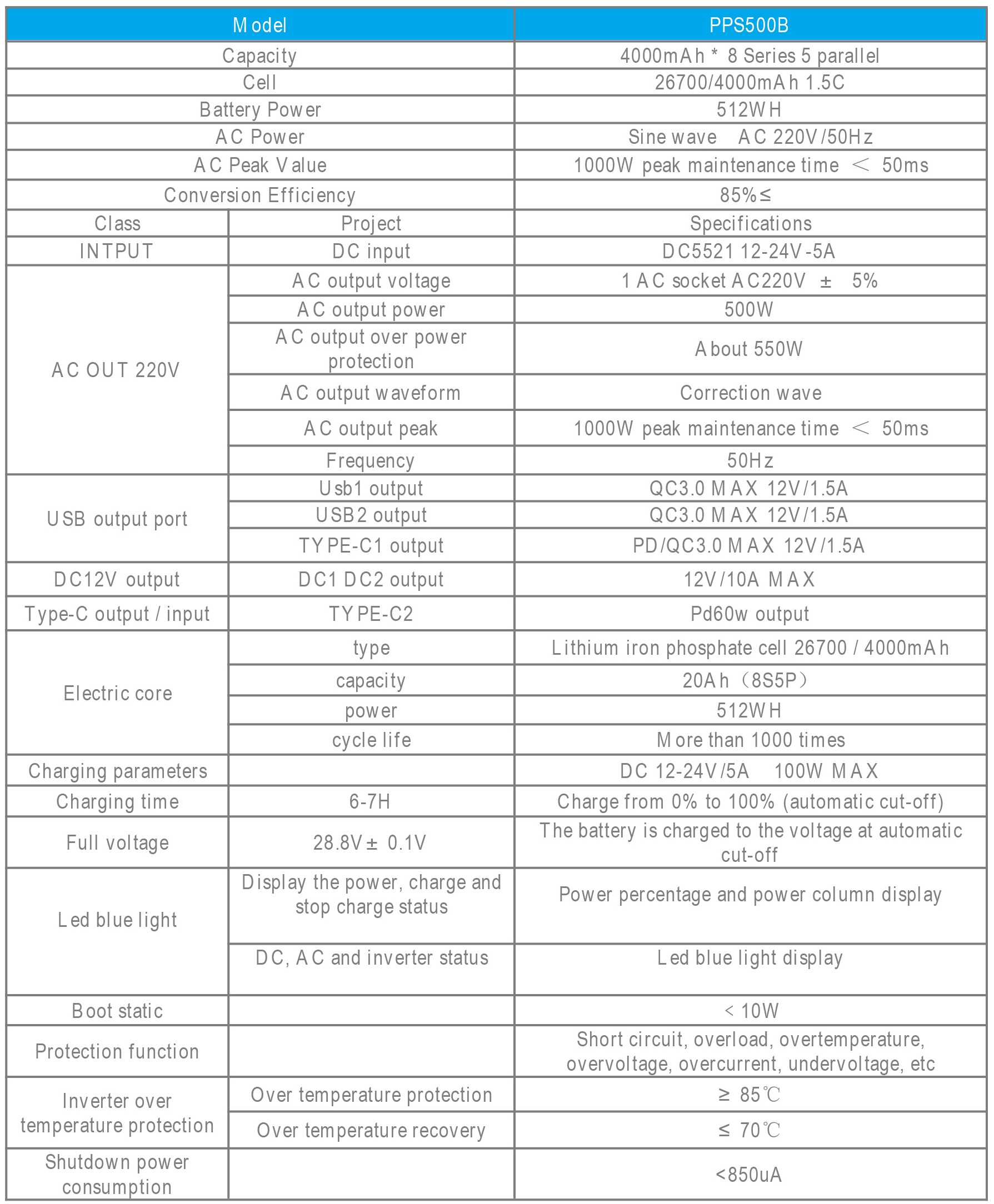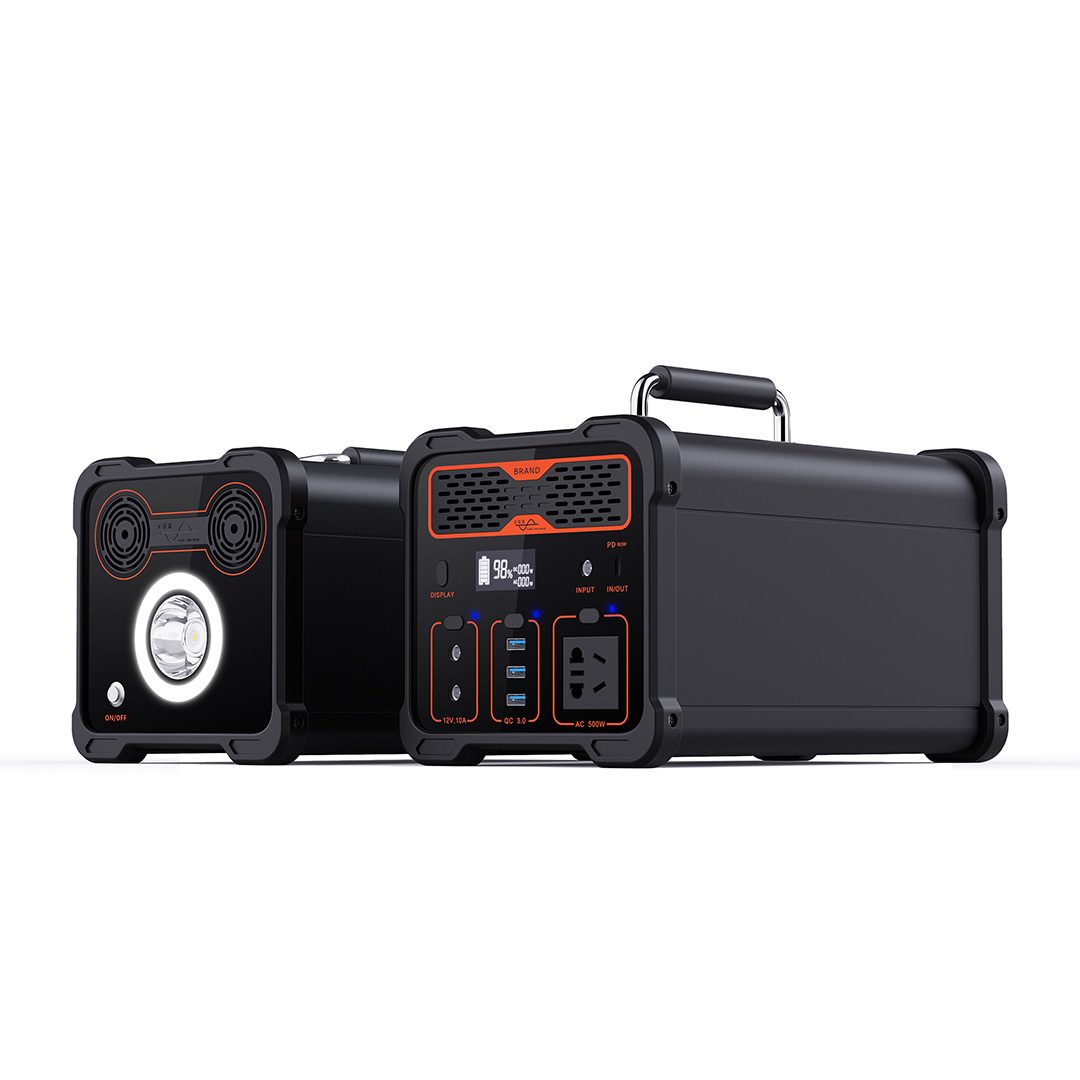Overview
Quick Details
|
Output Interface:DC, Type C, USB/DC, USB/MICRO USB
Input Interface:usb, DC, AC, TYPE-C
Function:Quick Charge Support, LED Display, Wireless Charging, Magnetic, Holder
Private Mold:Yes
Type:Ultra Slim, Fast Charging, With Plug, High Capacity, With Cable, PORTABLE, Power Staion, LED Display, for outdoor
Battery Type:18650 Lithium Battery, Lithium battery 512WH
Place of Origin:Guangdong, China
Brand Name:OEM
Model Number:PPS500B
Weight:7.5KG
|
Socket Standard:For USA/Canada, For E.U.
Protection:Over-discharging, Short Circuit Protection, Over-charging, Low Tension, overload, overcharge, discharge protection
Capacity:500W
Input voltage:110/120VAC or 220/230/240VAC
Transfer Time:0ms
Display:LCD Display
Warranty:12 Months
Certification:CE/ROSH/ISO
Wave Form:Pure sine wave
Material:Metal case
|
Packaging & Delivery
Selling Units:Single item
Single package size: 35X22X26 cm
Single gross weight:8.000 kg
Package Type:
10.1 number of packages: 1PCS
10.2 box size: 353*222*260MM
10.3 gross packing: 7.5 kg
Lead Time:
Quantity(sets)
|
1 - 10
|
>10
|
Est. Time(days)
|
7
|
To be negotiated
|
Specifications

FAQ
Frequently Asked Questions
Check out our frequently asked question database for answers. If you can't find your questions or answers here, please contact us and we will get back to you.
What is a UPS?
An uninterruptible power supply, also uninterruptible power source, UPS or battery/flywheel backup, is an electrical apparatus that provides emergency power to a load when the input power source, typically the utility main, fails.
Why do I need a UPS?
Power disturbances and blackouts can be costly. Preserving Information, the availability of equipment critical to the business, maintaining fully occupied staff, reduction of cost over-runs, performing reliably and getting results on time are all key elements in any successful operation. A UPS will provide clean, stable power to critical application equipment throughout utility power disturbances and power failure.
How many types of UPS are there?
There are three typical types of UPS: OFF-LINE, ON-LINE, and LINE INTERACTIVE.
What is an " ON LINE UPS ?"
An Online UPS takes incoming power, converts it to DC, conditions it, and converts it back to AC. This means the UPS is Online since there is no delay to switch to battery. Use an online UPS for your critical applications, high availability servers, etc. The output of these online UPS systems are TRUE sine wave, and is usually better than power from the electric company.
What is a "LINE INTERACTIVE UPS ?"
An Online UPS takes incoming power, converts it to DC, conditions it, and converts it back to AC. This means the UPS is Online since there is no delay to switch to battery. Use an online UPS for your critical applications, high availability servers, etc. The output of these online UPS systems are TRUE sine wave, and is usually better than power from the electric company.
How to choose the right UPS?
1. Understand specifications of all UPS.
2. Consider the requirements of power quality.
3. Understand the current capacity of UPS and consider the future expansion.
4. Choose reputed brands and manufacturers.
5. Choose UPS based on your requirements.
What are the important items you should evaluate when buying a UPS?
1. UPS reliability and stability.
2. The excellent engineers and the ability of products creation.
3. High efficiency and low noise.
4. Suppliers' reputation and financial situation.
5. International safety approvals such as TUV,UL,CSA, and so on.
6. Plant certifications such as ISO9001, ISO9002, and so on.
Where I live seldom occurs power failure will I still need a UPS?
In fact, power failure is one of power problem. The other power problems such as high voltage, low voltage, and spike are the main problems. The purposes of UPS is to provide customers the overall power protection such as voltage regulation, surge protection, spike, and sags protection. It also provides extended back up time without any limitation.
What could I use for the RJ11 connector on the rear panel of UPS?
RJ11 connector is used to protect the phone line. Hence, you can connect your phone; fax machine, modem and ADSL with it for better protection.
How many kinds of Power problems?
Except the blackout, there are Sags, Spikes, Surges, Noise & Transients will make the PC or other high technical equipment damage or shorten the lifetime.
What kinds of equipment should I use with the UPS? Is there any limit for it ?
Normally, the UPS is used for PC, high technical equipment & medical appliances. Because of most UPS are designed for PC, so not all the equipment could be connected with it. Especially, conducting loads just like cooling fans, refrigerators that have the motors. These kinds of equipment will damage the UPS. Moreover, copy machine and laser printers that have huge starting current also could not be used with UPS. The huge starting current will impact the capacity of UPS.
What is the impact of different output waveforms?
There are three major types of loads: Resistive load (Lamps); SPS load (PC power supply) & Conductive Load (Motors). All the types of load can be used with Pure Sinewave. However, only Resistive and SPS loads can be used with Modified Sinewave.
What is the impact to the PC with different transfer time?
Except On-Line UPS, there will be a short transfer time between 2ms to 10 ms for the power transformation with OFF-LINE & LINE INTERACTIVE UPS. Normally, when the blackout happens, the power supply of PC could continue the power for 16ms. Hence, most PC will still work functionally with the short transfer time.
What is the battery type of UPS?
Most UPS use Lead-acid maintenance-free batteries. This kind of battery is sealed so the UPS can be located with any direction and it does not void the poison gas during charging and discharging. So it also could be an indoor installation.
What is the lifetime of batteries?
The battery lifetime depends on the ambient temperature and the times of charging and discharging. Higher ambient temperature and too many charging and discharging times will reduce the lifetime. Normally, the battery lifetime is close to three years.

